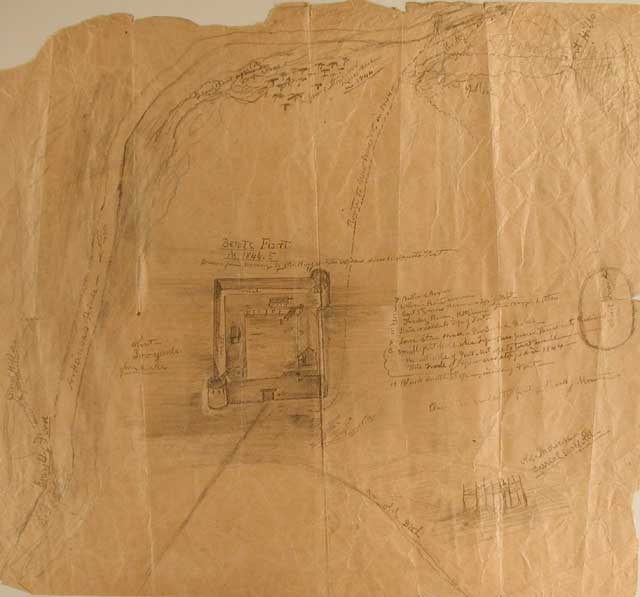CLICK HERE FOR A PDF VERSION OF THIS CONTENT

The Old Bent’s Fort Map drawn around 1850 by Will Boggs, an associate of Kit Carson, gives a sense of the design and surroundings of Bent’s Old Fort Most of the Boggs’ detail focuses on the structure itself and the illustration suggests the fort was built to be largely self-sufficient. The fort had trade and council rooms, sleeping quarters, storehouses, a wagon room (that could house 15 wagons), and a stone-lined well. Billiards, chess, dances, and even a racetrack outside the fort provided entertainment for travelers and the laborers housed within the walls. The fort was defended by high walls with two towers, a swivel gun, and two six-pound canons. The corral had lower walls planted with cactus to protect horses and mules.
The existence of Boggs’ map hints at the importance of the fort. Boggs spent the winter of 1844 at the fort; six years after his visit, Boggs drew the map from memory. The map’s relative accuracy implies that Bent’s Fort held an important place in the mind of Will Boggs; that he put his memory of Bent’s Fort into a visual representation years after his visit, suggests that he also recognized its importance to others. For historians, his map gives a glimpse at an important cultural center of the mid 1800s.
History of Bent’s Old Fort
Bent’s Fort was the joint project of William Bent, his brother Charles Bent, and Ceran St. Vrain. After deciding on a location with input from Cheyenne leaders, construction began in 1833 and was completed in 1834. William managed the fort, Charles took care of business in St. Louis and bossed the caravans traveling to Santa Fe, and St. Vrain worked with government officials in Santa Fe. Late fall through winter was the busiest time of the year due to the buffalo robe and fur trade. In 1840, for the first time in memory, the Cheyenne, Kiowa, Apache, and Comanche people made peace; they used Bent’s Old Fort to trade with one another in both goods and stories. In May 1846 the U.S declared war on Mexico and the fort was used as a supply station by the Army of the West. The U.S. offered no compensation for the fort’s use; this, along with the overhunting of buffalo and a shortage of firewood and grazing, took a heavy toll on the fort. In 1849 the fort was abandoned after an outbreak of cholera. In 1861 the Old Fort was again put to use as a stage station and was on the official US mail route to New Mexico. In 1863, it gained its first government appointed postmaster and it was reported that the station was a depot of the Kansas City and Santa Fe Stage Company in 1866. In 1867, two ranchers bought the fort and used it as a headquarters for their cattle operations. The post office closed in 1873, but the fort was still in use by ranchers. It is unknown when the fort was last abandoned, but the arrival of the railroad and the changing of stage routes likely played a pivotal role. Around 1900, settlers began taking the adobe and by 1916 there was little left of the walls. In 1926 the Daughters of the American Revolution took ownership of the fort; they transferred the land to the State Historical Society of Colorado in 1954. In 1960 the site came under the administration of the NPS. Archaeological work in the 50s and 60s recovered 1000s of artifacts and charted the walls and rooms of the fort. In 1975, a full-scale reconstruction of the fort was undertaken using the charts from the archaeological work and from the sketches of Lieutenant James W. Abert. After abandoning the Old Fort, a New Fort was completed at Big Timbers, about 40 miles down the Arkansas River, in 1853. Big Timbers was closer to the buffalo range, had plenty of wood, grass, and water, and was the favored winter camping area of the Cheyenne. It was also the first location discussed before the building of the old fort in 1833. Government freight contracts went through the New Fort and William Bent was appointed Indian Agent in 1859. Bent died in 1869 and, only a few years later, the Cheyenne, Arapaho, and other tribes who had used Bent’s Fort were confined to reservations.
Historical Importance of Bent’s Old Fort
Bent’s Old Fort was the first permanent settlement in the central plains region, so it was a frequent stop for travelers, traders, and Native Americans; this also made it the center of civilization in the central plains region and, in a very literal sense, a crossroads of cultures: within the walls one could hear English, French, Spanish, Cheyenne, Arapaho, Comanche, Kiowa, and Apache. Boggs’ map can only hint at the fort’s subtext. To the local tribes, the fort was not only important for trade and supplies, but also as a gathering place—often an entire village of Cheyenne or Arapaho would camp within the fort’s walls and, at times, even warring tribes could come together at the fort for peaceful trade. To the U.S., Bent’s Fort was important because it was a key location for goods and services in a difficult region of the country. In a larger sense, this was a time of rapid geographic and economic expansion for the U.S. and Bent’s Fort played a pivotal role in enabling this expansion. On a personal level, Bent’s Fort was a cornucopia of interaction—diverse cultures mixed goods and services, beliefs and ideas, and histories and languages—and forged people like William Bent’s son George, who lived in both the Cheyenne and American cultures and left a definitive mark in each.
Additional References
- The National Park Service’s website for Old Bent’s Fort can be found at http://www.nps.gov/beol
- Explore History Colorado’s interactive, online Ben’t Old Fort exhibit at http://exhibits.historycolorado.org/bentsfort/bents_home.html#mountainMen
- Additional Readings: Bent’s Old Fort National Historic Guide by Mark L. Gardner
- Life of George Bent: Written From His Letters by George E. Hyde
- Halfbreed: The Remarkable Story of George Bent—Caught Between the Worlds of the Indian and the White Man by David Fridtjof Halaas and Andrew E. Masich
- Bent’s Fort by David Lavender
- Bent’s Old Fort: An Archeological Study by Jackson W. Moore Jr.
- The Southern Cheyennes by Donald J. Berthrong
- Down the Santa Fe Trail and into Mexico: The Diary of Susan Shelby Magoffin by Susan Magoffin and edited by Stella M. Drumm
- Wah-to-yah and the Taos Trail by Lewis Garrard
